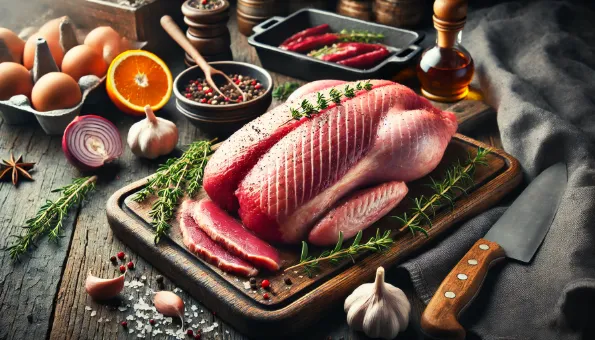Duck: Rich, Flavorful Poultry with High-Quality Protein, Heme Iron, B Vitamins & Renderable Fat
Duck meat (especially legs) offers complete protein, heme iron, B vitamins (B12, niacin), selenium and flavorful fat that can be rendered; mindful portioning balances its higher energy density.

What Is Duck Meat?
Duck (domestic breeds from *Anas platyrhynchos domesticus* or Muscovy *Cairina moschata*) is **darker, more robustly flavored poultry** compared with chicken or turkey. High myoglobin content in active flight muscles gives redder color and richer taste. Cuts: breast (magret when from force-fed Moulard for foie gras production), legs/thighs, wings, whole duck, fat/skin, liver (foie gras requires separate ethical considerations).
Nutrition (per 100 g cooked, skin-on vs skinless breast)
| | Skin-On Breast | Skinless Breast |
|---|---|---|
| Calories | ~200–210 kcal | ~140–150 kcal |
| **Protein** | 19–20 g | 23–24 g |
| **Fat** | 13–15 g | 4–5 g |
| – Saturated | 4–5 g | 1.2–1.5 g |
| **Iron (heme)** | 2.3 mg | 2.3 mg |
| **Zinc** | 1.5–1.8 mg | 1.5–1.8 mg |
| **Selenium** | 14–16 µg | 14–16 µg |
| **B Vitamins** | Niacin, B6, B12 notable | Slightly higher per kcal |
Leg (confit) tends to be higher in fat; rendered duck fat (~115 kcal/Tbsp) is mostly MUFA + SFA.
Potential Benefits
- **Complete protein** for muscle maintenance & satiety.
- **Heme iron & zinc** support oxygen transport & immune enzymes.
- **Selenium + B12 + niacin** aid antioxidant enzymes & energy metabolism.
- **Fat composition**: significant monounsaturated (oleic) plus saturated; rendered fat has higher smoke stability than many polyunsaturated oils.
- **Culinary versatility**: distinct flavor allows satisfaction with modest portions.
Drawbacks & Precautions
- **Higher calorie & saturated fat** (especially with skin) may challenge lipid goals if portions are large.
- **Foie gras production** raises **ethical & animal welfare concerns** (force-feeding); choosing non–force-fed sources or standard duck meat can align with welfare preferences.
- **Food safety**: cook to **internal 74 °C (165 °F)** for ground duck / fully cooked products; whole muscle breasts are often served medium (60–63 °C) in fine dining—use reputable sources and understand risk.
- Rendered fat is energy-dense; overuse increases calories.
- **Allergy** rare but cross-reactivity possible with other avian meats in sensitive individuals.
Culinary Uses
- **Pan-seared breast:** Score skin (avoid cutting meat), render slowly skin-side down until crisp; finish at lower temp.
- **Confit:** Cure legs (salt, aromatics), cook submerged in rendered fat at low temp until tender; shred for salads, cassoulet, tacos.
- **Roast whole duck:** Prick skin & air-dry to improve crispness; collect rendered fat for future cooking (potatoes, vegetables).
- **Stocks & sauces:** Carcasses produce gelatin-rich stock; reduced into demi-glace or orange / cherry gastrique.
- **Duck fat applications:** High flavor for roasting root vegetables, frying potatoes or sautéing mushrooms.
- **Ground duck:** Burgers, meatballs (blend with lean meats to moderate fat).
Technique & Optimization
- **Score & render**: Shallow crosshatch scoring enlarges surface area to melt subcutaneous fat without curling.
- **Dry the skin** (refrigerate uncovered 8–24 h) for superior crispness.
- **Gentle finishing**: After rendering, finish in oven ~160–180 °C to target medium doneness; rest to redistribute juices.
- **Confit safety**: Maintain low poaching temp (90–95 °C), fully submerge in fat, chill promptly; store legs covered in fat (refrigerated) up to 1 month.
- **Fat clarification**: Strain warm rendered fat through fine mesh + cheesecloth; store chilled (3–6 months) or freeze.
Health Context & Portioning
- **Portion guide**: 85–100 g cooked meat (without excess skin) offers protein & iron while moderating calories.
- Pair with **fiber-rich sides** (braised greens, lentils, whole grains, citrus salad) to balance richness.
- Replace some saturated cooking fats with rendered duck fat only if overall diet is low in saturated fat; monitor total intake.
- Trim excess surface fat after rendering to reduce final load.
Sustainability & Ethical Notes
Smaller-scale duck operations can integrate with **wetland/rice systems** (nutrient cycling, pest control). Selecting producers with **responsible waste management, humane handling & avoidance of force-feeding (if you choose not to support foie gras practices)** improves ethical footprint. Utilize all parts—meat, bones, fat—to **minimize waste**.
Storage
Raw duck: refrigerate ≤4 °C, use within 1–2 days (whole) or 1 day (ground). Cooked meat: 3–4 days chilled. Rendered fat: airtight refrigerated 3–6 months; freeze up to 1 year. Confit (legs submerged in fat) keeps refrigerated up to 1 month; reheat to bubbling before service.
Key Takeaways
✔︎ Nutrient-rich, flavorful high-quality protein (iron, B12, selenium)
✔︎ Renderable fat for culinary applications & portion satisfaction
✖︎ Higher saturated fat & calorie density—use technique & portion control; consider ethical sourcing.
- 1. Duck
Used for its rich flavor and high fat content

